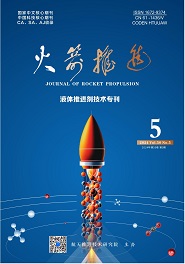航天推进技术研究院主办
QIN Yongtao,GAO Qiang,WU Rongyan,et al.Physicochemical characteristic analysis on shoulder ring flaw of pressure boost gas valve in liquid oxygen supply system[J].Journal of Rocket Propulsion,2015,41(04):67-73.
液氧增压气体阀门肩圈的裂纹理化特性分析
- Title:
- Physicochemical characteristic analysis on shoulder ring flaw of pressure boost gas valve in liquid oxygen supply system
- 分类号:
- V431-34
- 文献标志码:
- A
- 摘要:
- 针对某发动机试验区的液氧供应系统增压气体阀门肩圈工作过程出现的裂纹现象,为保证气体供应正常,确立裂纹出现的主要原因,避免试车安全隐患,首先从宏观观察,对表面型貌和断面进行观察,然后对肩圈进行理化分析,从基体上确定材料成分,结合裂纹源区断口腐蚀形貌进行金相组织检查,确定裂纹腐蚀特性;对裂纹腐蚀特性进行材料成分、加工工艺、硬度进行检测,分析肩圈材料力学性能分析,并结合能谱分析、铁素体测量、残余应力分析,确定裂纹腐蚀特性根源与因素,同时结合有限元的应力分析,分析应力腐蚀的主要原因和诱导因素,研究肩圈裂纹的内在机理;在此基础上,制定使用过程的防范措施,确保使用过程的肩圈性能。
- Abstract:
- Aiming at the shoulder ring flaw phenomenon occurred in the working process of pressure boost gas valve of liquid oxygen supply system in a liquid rocket engine testing process, surface morphology and section morphology of valve shoulder ring flaw were checked by macroscopic observation, and physicochemical analysis of valve shoulder ring was performed to avoiding hidden danger in liquid rocket engine testing process, to assure the normal gas supply and determine the main source of flaw. The corrosion property was confirmed by observation of fracture corrosion morphology metallographic organization in flaw source zone and flaw expansion zone, and by material analysis of shoulder ring matrix. The material composition, processing technology and hardness were corrosion property were defined by energy spectrum analysis, ferrite measurement and remnants stress research. The main source and inducing factors of stress corrosion were determined by finite element analysis for further researching the inner mechanism of valve shoulder ring flaw. Finally, the precautionary measures of valve shoulder ring flaw were established to assure valve performance and provide a support for safety and reliability of liquid rocket engine testing process, and an approach for physicochemical characteristic analysis of others equipments.
参考文献/References:
[1]孙秋霞. 材料腐蚀与防护[M]. 北京: 冶金工业出版社, 2001.
[2]许淳淳, 张新生, 胡钢. 不锈钢冷加工形变诱发马氏体相变及其腐蚀行为[J]. 材料保护, 2002, 35(3): 15-17.
[3]肖纪美. 不锈钢的金属学问题[M]. 北京: 冶金工业出版社, 2006.
[4]罗鑫. 304不锈钢的晶界特征分布及其对应力腐蚀开裂的影响[D]. 上海: 上海大学, 2009.
[5]夏爽. 690合金中晶界特征分布及其演化机理的研究[D]. 上海: 上海大学, 2007.
[6]ANDLE V. Twinning-related grain boundary engineering [J]. Acta Mater, 2004, 52: 4067-4070.
[7]LEE S L, RICHARDS N L. The effect of single-step low strain and an nealing of nickel oll grain boundary character [J]. Mater Sci Eng A, 2005, 390: 81-85.
[8]陆永浩, 褚武扬, 高克玮, 乔利杰. 304L不锈钢在高温水中的应力腐蚀裂纹扩展[J]. 金属学报, 2004, 40(7): 763- 767.
[9]GOTTSTEIN G, MA Y, SHVINDLERMAN L S. Triple junction motion and grain microstructure evolution[J]. Acta Mater, 2005, 53: 1535-1544.
[10]陈鸿海. 金属腐蚀学[M]. 北京:北京理工大学出版社, 1995.
[11]马毅. 奥氏体不锈钢的应力腐蚀研究[D]. 大连:大连理工大学, 2009.
备注/Memo
收稿日期:2014-12-04;修回日期:2015-01-29 作者简介:秦永涛(1981—),男,工程师,研究领域为液体火箭发动机试验技术
